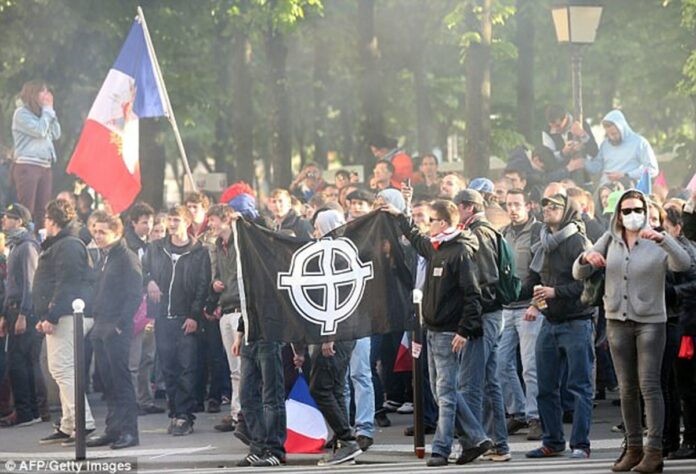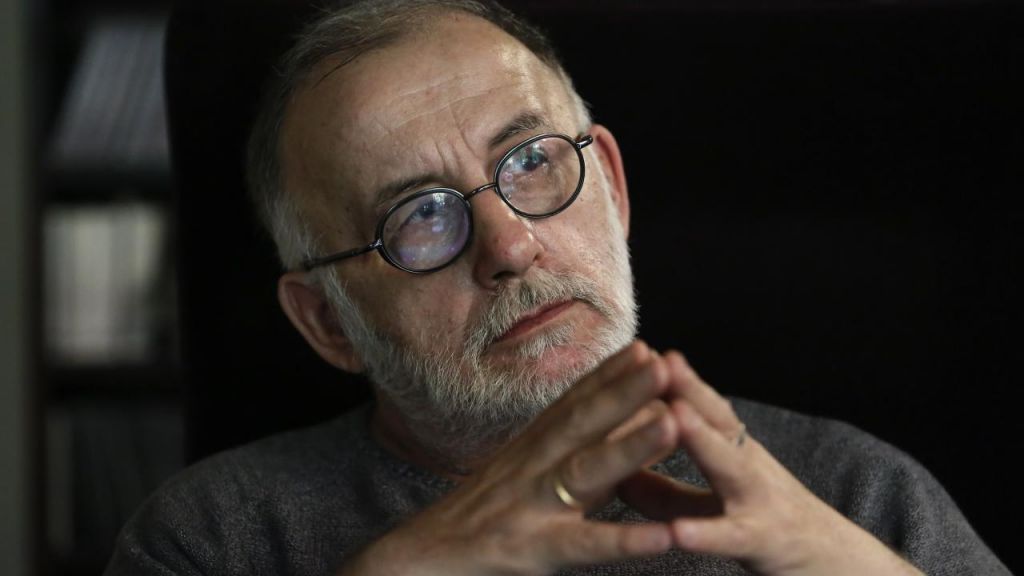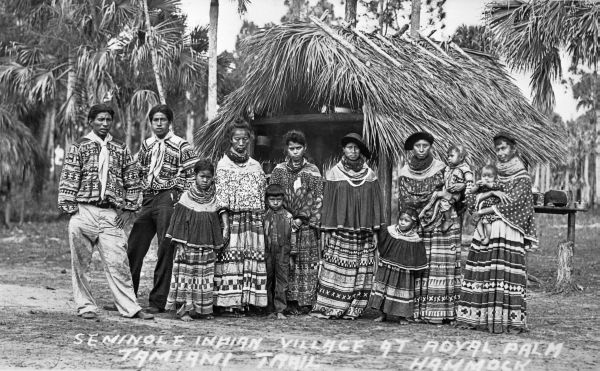Our previous article showed how Macron’s policies are closer to the far-right than he’d like to admit. The recent immigration law proposed by his Minister for the Interior is literally inspired from the French far-right doctrine of “national preference” (meaning French citizens should have priority in accessing public services over legal immigrants).
The fact that this law was touted as an “ideological victory” by Marine Le Pen, the head of the far-right party Rassemblement National (RN) is a symptom of how much the far-right has been winning since Macron took power in 2017.
But this shift to the right doesn’t stop in the realm of parliamentary politics, it creeps into the daily lives of ordinary people in France. It has become socially “acceptable” for white French people to say things like “I’m not racist but…” (“there are too many foreigners here” or “those immigrants are all just thieves”, or any other sentence that reeks of xenophobia and racism).
The media
One of the key pathways to the “droitisation” (the French political scene becoming more right-wing) is through the mainstream media. In France, as in most countries, big media outlets are controlled by oligarchs. Le Monde Diplomatique, one of the few semi-independent left-wing magazines in France, has been publishing since 2016 a map of who is controlling the French media. To give just a few examples of oligarchs involved in the media, we can cite:
- Vincent Bolloré, a Catholic fanatic billionaire whose business focuses on extractions in Africa, and who owns some of the most popular TV and radio channels alongside Arnaud Lagardère, including Canal+, Europe 1, RFM, Paris Match.
- Arnaud Lagardère, billionaire heir to a publishing group, very much laissez-faire capitalist.
- Bernard Arnault, multibillionaire, runs the world’s largest luxury goods company LVMH, and controls a right-wing economics newspaper (Les Echos) and the most read newspaper in Paris (Le Parisien).
- Patrick Drahi, billionaire investor in telecom (Altice), owns some of the most popular 24h news-channels, the very right-wing BFM TV, RMC, and i24.
In addition to these billionaires, there are also a number of banks and religious institutions that own or control regional media outlets.
One of the worst TV shows that has been promoting far-right ideas is called “Touche pas à mon poste!” (TPMP), literally “Don’t Touch My TV Set!”, and run by the infamous Cyril Hanouna. The show is hosted by the channel C8, part of the Canal+ group owned by Vincent Bolloré. The TV show has been criticised for giving the far-right more visibility and a platform to promote itself. A study on the electoral pre-campaign noted an impressive over-representation of the speaking time granted to Eric Zemmour (far-right politician of the Reconquête party) in the airtime that TPMP devotes to politics. So much so that the far-right represented 53% of these segments.

The 24h news-channels that exist in France are all but one owned and controlled by these oligarchs (Patrick Drahi, Daniel Kretinsky, and the Bouygues family). These channels are very much conservative and right-wing and in general, the far-right candidates and politicians do get more airtime than left-wing politicians on these media.
The real-life consequences
Most of the messaging on the TV, radio, newspaper and the internet coming from these media is focused on instilling fear into their audience: fear that they are in danger because of foreigners coming over to “steal their jobs”, “steal their welfare”, or “steal their wife”. When you turn on the 24h news channels, most of the news is about how foreigners of Arabic or African origin have committed violence against the “native” French. Very little data is available about the proportion of news items about violence (“faits divers” in French) in the news but one study in 2012 noted that the number of news items about violence had increased by 73% across all media between 2002-2012, even though the statistics about violence showed a different picture – that the number of violent acts had actually gone down.
Creating this sense of insecurity among the white population through reports about “hordes of Muslims” pillaging the streets or raping white women, and promoting the concept of “anti-white racism” on the media, has created the perfect storm for real-life violence to happen, only the other way round. Indeed, in November 2023, a young French gardener of North-African origin was violently attacked by a 70 year-old white French man. The perpetrator wanted to cut the victims throat but luckily the young man’s injury was not life threatening. Despite the racist insults that were yelled by the attacker, the justice system decided that this was not a hate crime.
Acts of violence against the immigrant population are perpetrated daily by police forces, especially in slums hosting Roma population and in tent camps where refugees are trying to find a temporary place to stay. Under these circumstances, random acts of violence perpetrated by racists against people of colour are bound to increase in the coming months or years. And this time, they could be better organised.
The rise of neonazi and fascist groups
Indeed, the number of neonazi, fascist and nationalistic (violent) groups has increased in the past years, and not only that, they have become more visible and less ashamed to show off. For instance, the number of arrests for far-right terrorism has exploded since Macron became president: on average 17 arrests per year between 2017-2022 compared to 2.5 arrests between 2011-2016. This does not reflect a policy to deal with racist violence, but rather the fact that there were so many attacks that the police had no choice but to arrest some of the perpetrators.
Around the time of the attack on the gardener mentioned above, two other acts of violence happened, but this time the victims were white and the perpetrators of North-African descent. The first one was a horrific murder of a 12 year-old girl by an Algerian woman (who seems to have psychiatric problems), and an 18 year-old boy who was stabbed to death during a fight outside a disco club. These awful events were instrumentalised by the far-right as examples of “anti-white racism” and that immigrants are a security threat. A number of far-right groups have taken it to the streets to protest against immigration, most of them linked to Éric Zemmour’s far right party Reconquest. Fascist vigilante militia had started to roam the streets in the city of Lyon, for example, knives out and yelling racist insults to the passers-by. This type of vigilante militia going on the streets and intimidating or attacking people is called “ratonnade” in French, and was very common during the Algerian independence war in the 1950-60s. The number of ratonnades has significantly increased under Marcon. Soon after the killing by the police of Nahel, a French teenager of North-African descent, young people took to the streets to express their anger at being the victims of police violence. There were also more peaceful protests to commemorate his death. In parallel, the far-right militias and fascist groups such as GUD (Groupe Union Défense), Génération Identitaire, Alvarium and others have initiated several ratonnades in various cities across the country during night-time, and have also gathered during daylight in public places and launched appeals to start a “racial civil war”. Some fascist individuals have also called on Telegram groups to go to the peaceful protest for Nahel and start beating up people there. However, the police didn’t seem to be alarmed by this violence, and very few arrests were made.
In addition to the ratonnades, some far-right fascist groups have started to put anti-immigration banners and posters in the neighbourhoods where the majority of the population is non-white (although not necessarily immigrant). For instance, in November 2023, a number of posters inscribed “French people, immigration kills” were displayed in a social housing neighbourhood by the local cell of the Action Française, a far-right monarchist political movement originally founded in 1899. The neighbourhood has a mixed population of both white and people of color, some French and some legal immigrants, and it is not particularly known for having the “classic” problems that social housing projects are victims of (drug trafficking, violence, extreme poverty, etc.). This type of posters and banners have cropped up in various places in neighbourhoods like this one, and have made its non-white inhabitants feel unsafe.
The French authorities do not seem to take any concrete steps to address this violence. It is no wonder, since 60% of the police force intended to vote for Marine Le Pen in 2022.
Two recent examples give a sense of how the police forces and the far-right are so well connected. The first one is when an ex-cop dressed up as a fake police officer from the BRAV-M (The Brigade for the Repression of Motorized Violent Action) and went to the TV show TPMP mentioned above, and launched a protest appeal in support of the police-officer who killed Nahel. This man has openly stated his support for the two far right parties, Rassemblement National (RN, Marine Le Pen’s party) and Reconquête (Éric Zemmour’s party). The second example is when 500+ neo-nazis from the Comité du 9-Mai (9th May Committee), a fascist group created in the memory of one of their members’ death on that day in 1994, marched across the streets of Paris in early May 2023, completely unbothered and even protected by the gendarmerie and police forces while the pension reform protests were violently repressed a few streets away.
The swarming of these far-right groups and militias is increasingly visible in past years. The common pattern is that although some of them are officially banned, they are reborn under similar names, much like a phoenix or a hydra. Génération Identitaire (Generation Identity) is one example, famous for their “Defend Europe” crusade in the Pyrénnées mountains a few years ago. It was banned in 2021 due to its violent actions that even Macron’s government couldn’t deny. However, its members still gather together but their groups have taken up other names. Moreover, GI was the youth wing of Les Identitaires, which is one of the largest far-right militant groups in France, with a European outreach. Another important point is that, unlike the left where different opinions mean that groups won’t necessarily join forces together in a protest, these far-right militias go beyond different takes on specific topics (e.g. immigration, anti-zionism, etc.) and unite under the same ideology, coming together during protests or public events. This united front allows them to be fluid and flexible enough in front of authorities. Oftentimes, members of one group are also members of other groups; these groups don’t see each other as competing in the ideology pit, but rather as different cells of the same body, fulfilling different tasks.
With the media controlled by far-right or conservative oligarchs, and with the Left having largely lost its roots in working class neighbourhoods, people are left prey to disorientation campaigns. The only place where the Left can communicate in some way with the population is online, where a number of independent and left-leaning media exist (Médiapart, Le Média, Blast, etc.), but the outreach is still limited to urban, middle-class, young, intellectual readers and viewers. And certainly this form of communication is not sufficient to counter the far-right propaganda. The main places where this can take place are workplaces and neighbourgoods.
Unfortunately, the French Left is far from engaging in a united front approach and far from being able to propose a credible alternative to the stream of neoliberal and conservative ideas flowing freely in France. The media is not just muzzled but used as a megaphone for the far-right ideology. Immigrants are intimidated daily not just by the police, but by fascist vigilantes. Nonetheless, the recent protests coming from the agricultural sector have brought on some hope. While the majority of farmers are affiliated with the corporate union FNSEA, a smaller union called Confédération Paysanne (Peasant’s Confederation), affiliated with Via Campesina, have been very vocal about their anti-fascist ideas, demanding ecological solutions to their struggles rather than business-as-usual solutions. The recent protests against the immigration law are also a glimmer of hope. These add to the recent protests against the pension reform, and the protests after the killing of Nahel. Some years ago, the gilets jaunes (Yellow Vests) movement shook French society. There is huge power in the hands of the French working class, with its long traditions of struggle. But more needs to be done in terms of countering the far-right and neo-nazi threats, and that means proper political strategising and united action coming from the Left.













